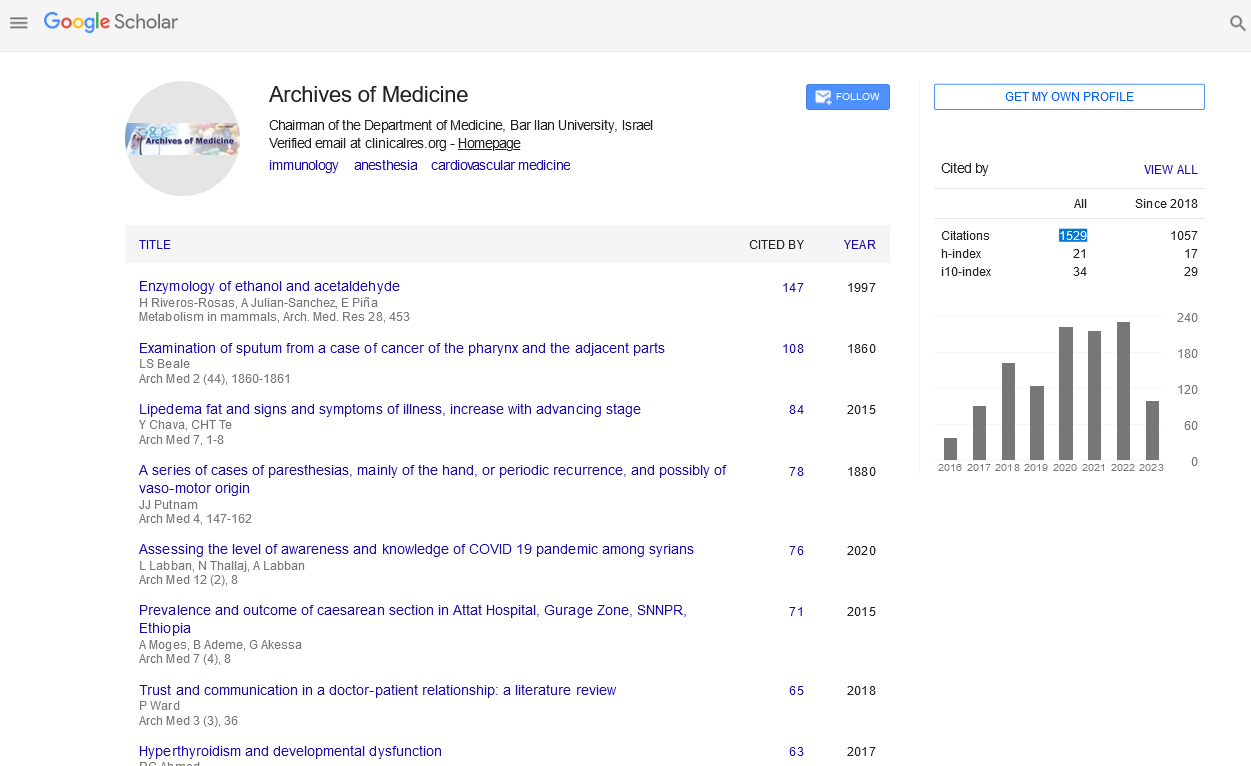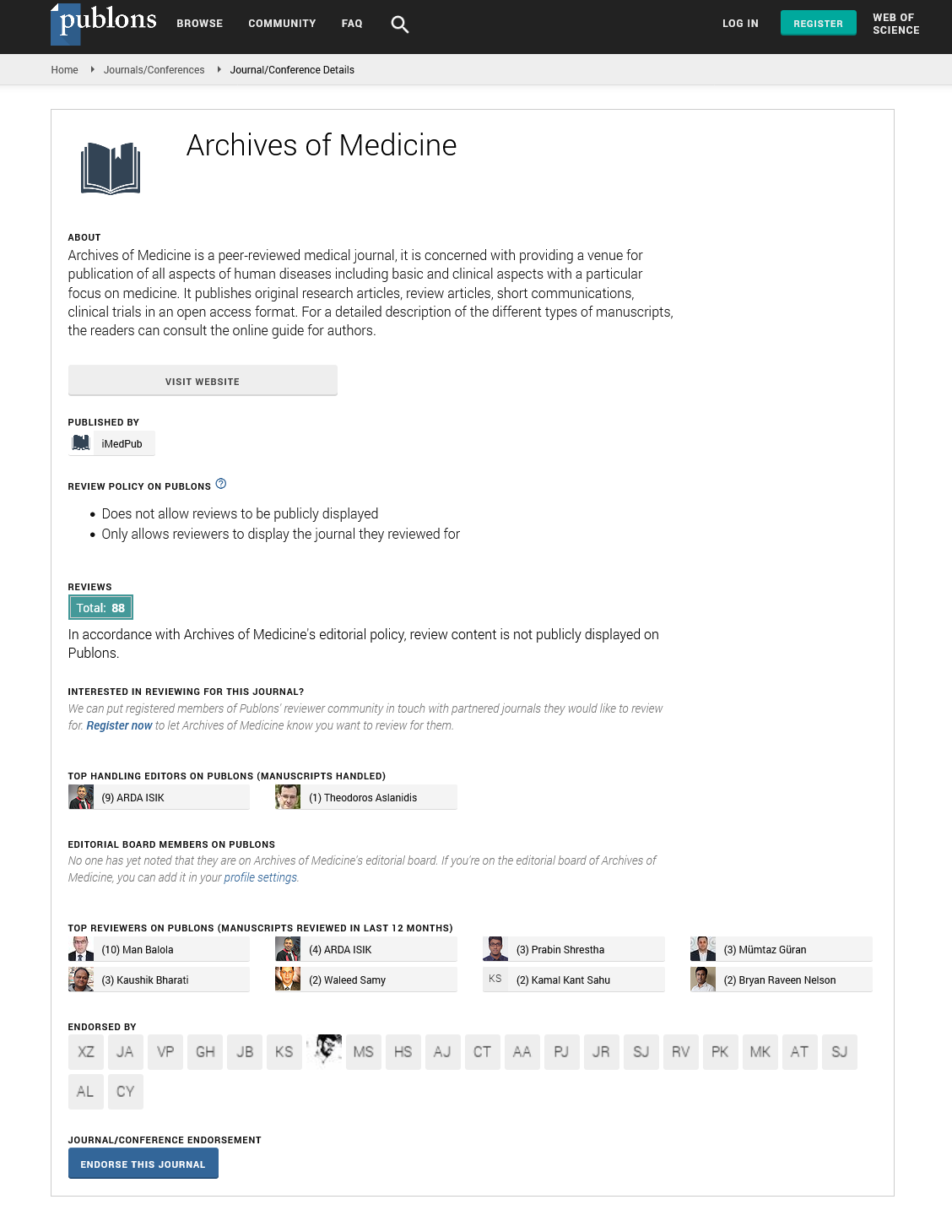Opinion - (2022) Volume 14, Issue 6
The use of near infra-red radiation imaging
David M*
Department of Medicine & Advanced Technology, Seoul National University Hospital, Seoul, Korea
*Correspondence:
David M, Department of Medicine & Advanced Technology, Seoul National University Hospital,
Seoul,
Korea,
Email:
Received: 25-May-2022, Manuscript No. ipaom-22-12951;
Editor assigned: 28-May-2022, Pre QC No. p-12951;
Reviewed: 17-Jun-2022, QC No. Q-12951;
Revised: 22-Jun-2022, Manuscript No. R-12951;
Published:
30-Jun-2022
Abstract
Left ventricular mechanical dispersion measured by two dimensional
speckle tracking echocardiography (MD) is a novel strain derived
parameter that reflects temporal cardiac contraction heterogeneity
and has consequently gained attention as a predictor of increased
arrhythmic risk in selected cardiac diseases.
Keywords
Left ventricular; LVEF; Mechanical
Introduction
LV Near Infrared Spectroscopy and Imaging (NIRS) utilizes
close to infrared light somewhere in the range of 650 and
950 nm to painlessly test the fixation and oxygenation of
haemoglobin in the mind, muscle and different tissues and
is utilized for example to distinguish changes prompted by
mind movement, injury, or infection. In cerebrum research
it supplements useful attractive reverberation imaging
(fMRI) by giving proportions of both oxygenated and
deoxygenated hemoglobin fixations and by empowering
concentrates on in populaces of subjects with trial standards
that are not agreeable to fMRI [1-5].
The close to infrared (NIR) contains low recurrence
radiation adjoining red shades in the noticeable. The
splendour we find in the NIR is because of reflected daylight;
not to temperature as many individuals, including a few
experts, erroneously accept. In the NIR visual items are
accessible, rock brilliance is higher, and the more extended
frequencies are impacted less by air dissipating. Be that as it
may, the significant benefit of utilizing the NIR its aversion
to vegetation type, thickness, water content, and general
plant wellbeing. Look out, however, colors on variety
NIR photos don't mean equivalent to colors on photos
in the noticeable area. The dominant absorbers in the
human body in the visible and near infrared wavelengths
are oxygenated and deoxygenated haemoglobin and water
visible wavelengths of light are strongly absorbed by
haemoglobin, decreasing significantly for the near infrared
wavelengths greater than 650 nm. Above 950 nm, water
absorption increases significantly. Thus, there is a window
between 650 and 950 nm where the absorption of light is
small and, despite the strong scattering of light by tissue,
the light is able to diffuse several centimeters through the
tissue and before it is detected.
Description
NIR-Raman spectroscopy has been utilized for various
applications and is especially helpful for natural and
biomedical purposes. Fluorescence has been a restricting
element for much Raman investigation of natural examples,
especially entire cell or entire tissue tests. NIR excitation
diminishes obstruction from fluorescence and diminishes
photo induced debasement of the example, empowering
scientists to get spectra for an assortment of biomaterials
and living cells.
While NIRS is normally performed utilizing
instruments that discharged nonstop wave light and
essentially measure the power of light engendered through
the tissue, it is additionally conceivable to perform estimations where the wellspring of light is power tweaked
(between 50 to 500 MHz) or beat and the identifier settle
separately the stage or transient postponement of the light
proliferating through the tissue. These estimations are
generally called recurrence space or time space estimations
and in light of the fact that they give direct estimations
of photon engendering postpone inside the tissue as well
as the power, it is feasible to gauge outright retention and
dissipating properties of the tissue notwithstanding the
progressions that can be assessed by persistent wave NIRS
. Moreover, it is feasible to use close to infrared light to
gauge blood stream harmlessly in the cerebrum utilizing
diffuse connection spectroscopy which takes advantage of
the way that photons experience a Doppler shift in their
frequency when they dissipate from moving red platelets.
Indocyanine green (ICG) is a fluorescent color which
ties plasma proteins in the vascular framework. Kodak
research centers developed ICG color for close infrared
(NIR) photography in 1955 and it was subsequently
endorsed by the FDA for clinical use in 1959. Once in
the blood stream, ICG quickly limits to lipoproteins and
it is as a rule removed by the liver seeming noticeable in
the bile 8 min after the infusion. At the point when ICG
in not infused in the circulation system, it arrives at the
closest depleting lymph hub in around 15 min. ICG use is
protected, with a portion of 0.1-0.5 mg/mL/kg for clinical
use. Because of its capacity to survey tissue vascularization
once recognized with a particular frequency of light, NIR
imaging with ICG infusion (NIR-ICG) has demonstrated a
valuable, practical and safe instrument during gynaecologic,
urologic and stomach related strategies for both harmless
and threatening infections. Specifically, NIR-ICG can be
utilized for distinguishing sentinel lymph hubs during
careful arranging for a few diseases (melanoma, prostate,
rectal or endometrial malignant growth).
Then again, for harmless circumstances, NIR-ICG
can be utilized with a few applications. For instance, it very well may be utilized as an aide during endometriosis
medical procedure working with intraoperative finding of
mysterious peritoneal and profound endometriosis sores
at white light. Moreover, it has been demonstrated helpful
in the assessment for anastomotic perfusion appraisal
after discoid or segmental resection for recto sigmoid
endometriosis (RSE). NIR-ICG color may likewise help
in the intraoperative appraisal of organ perfusion and
ischemia after ovarian detorsion and help the specialist's
intraoperative choice.
Conclusion
This study determined values of mechanical dispersion
in subjects with a normal EF and normal GLS. Further
studies are needed to clarify the relation between mechanical
dispersion and different cardiac disease
Funding
This research received no external funding.
Conflicts of Interest
The authors declare no competing interests.
All authors declare that the material has not been
published elsewhere, or has not been submitted to another
publisher.
Data Availability
Authors declare that all related data are available
concerning researchers by the corresponding author's
email.
Acknowledgments
None.
REFERENCES
- Rodriguez-Zanella H, F Boccalini, E Secco, et al. Left ventricular mechanical dispersion measured with two-dimensional speckle tracking echocardiography predicts severe arrhythmic events in patients with ischemic and non-ischemic cardiomyopathy." Eur Heart J Cardiovasc Imaging. 2017:iii80-
Google Scholar, Crossref, Indexed at
- Hensen Liselotte CR, Kathleen Goossens, Tomaz Podlesnikar, et al.Left ventricular mechanical dispersion and global longitudinal strain and ventricular arrhythmias in predialysis and dialysis patients. J Am Soc Echocardiogr. 2018;31:777-783
Google Scholar, Crossref, Indexed at
- Aagaard EN, Kvisvik B, Pervez MO. Left ventricular mechanical dispersion in a general population: data from the Akershus Cardiac Examination 1950 study. Eur Heart J Cardiovasc Imaging. 2020; 21:183-190.
Google Scholar, Crossref, Indexed at
- Haugaa, Kristina H, Nina E Hasselberg. Mechanical dispersion by strain echocardiography: A predictor of ventricular arrhythmias in subjects with lamin A/C mutations. JACC Cardiovascular Imaging. 2015: 104-106.
Google Scholar, Crossref, Indexed at
- Klaeboe LG, Brekke PH, Aaberge L, et al. Impact of transcatheter aortic valve implantation on mechanical dispersion. Open Heart. 2019 ;7:e001199.
Google Scholar, Crossref, Indexed at






